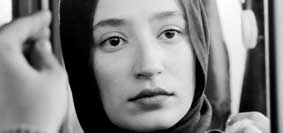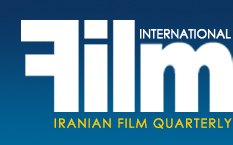|
Interview with Negar Javaherian for her part in "Here withouth Me"; an adaptation of The "Glass Menagerie":
Diving into the Depth of the Ocean
by Arameh E’temadi
|

She looks very serene and her serenity is not only manifest in her face, but also in her behavior. She is the simple girl of the Iranian cinema who takes her work seriously, but prefers to go on with her ordinary life instead of being submerged in the excitement of the world of arts and its controversies. Unlike many young figures that rise to stardom overnight and are rapidly forgotten, she thinks and muses on her parts in order to avoid unnecessary fluctuation in her career. She does not want short-lived appearance on front cover of magazines, but makes her choices with care. This is why she has been both creditable on the stage and in cinema for a whole decade.
Unlike many of her own generation, her success has not made her arrogant. You feel comfortable with her, can criticize her, and even chide her for being so down-to-earth. Negar Javaherian is happy with her situation and you can see this in her looks. She has every right to play villain characters once in a while. Despite her quite face, you can easily guess that her face is just a cover for the foamy river beneath it. Her latest appearance was in Bahram Tavakkoli’s Here without Me (2011), an adaptation of Tennessee Williams’ stage play, The Glass Menagerie. She was cast as Yalda, who was equivalent Laura in Williams’ play.
*
Film International: Had you read The Glass Menagerie before accepting Yalda’s part in this movie?
Negar Javaherian: I had read it many years ago. I read it first when I had just started to study theater at “School of Arts and Literature for Children and Young Adults.” I also read it in later years as a university student and performed parts of it. It is a famous play which is usually exercised at arts universities. I was familiar with it.
FI: Hopelessness and depression of people and general atmosphere of the play is one of its main characteristics. The character, Laura, is especially bereft of self-confidence and considers herself inside a glass menagerie where she thinks she should help the animals. Here without Me is somehow different. The play, for instance, puts the highest emphasis on Laura, but this is not the case with Yalda in Tavakkoli’s movie.
NJ: Even in the play, Laura is not the narrator and we here the narration from Tom. In both places, Amanda (mother) is the most prominent character, but Laura is also important because everybody is concerned about her. All characters are important in their own right, but Amanda is the key character with Tom narrating the story. I mean, none of those characters are marginal and you have difficulty pinpointing a central character.
FI: Depression and hopelessness is evident in Laura as well as Yalda. The difference, however, is that the animals with which Laura plays have been replaced with small glass animals in the movie and Yalda plays with them. After reading the screenplay, did you think that adaptation of that character, with all minor and major changes made to it, would be acceptable?
NJ: A few months before this screenplay, Bahram Tavakkoli sent me another non-adapted one which was totally different. When I read the screenplay of Here without Me, I was still under the influence of the previous screenplay and never thought that project will led to an adaption of The Glass Menagerie. The first time I read it, I loved it as much as I do now and it quite moved me. But as for differences between Laura and Yalda, such changes are quite possible in an adaptation. Although glass animals are very important in the play, just remember the unicorn which is in the play; due to cultural conditions, it could not have been present in the movie too and was, therefore, deleted.
... To Be Continued
[Page: 106]
|
|
|
|
|
President & Publisher
Massoud Mehrabi
Editors:
Sohrab Soori
Massoud Mehrabi
Translators:
Sohrab Soori
Vazrik Der-Sahakian
Behrouz Tourani
Zohreh Khatibi
Contributors
Mehrzad Danesh
Advertisements
Mohammad Mohammadian
Art Director
Babak Kassiri
Ad Designers
Amir Kheirandish
Hossein Kheirandish
Cover Design
Alireza Amakchi
Correspondents
E.Emrani & M. Behraznia (Germany)
Mohammad Haghighat (France)
A. Movahed & M. Amini (Italy)
Robert Richter (Switzerland)
F. Shafaghi (Canada)
B. Pakzad (UAE)
H. Rasti (Japan)
Print Supervisors
Shad-Rang
Noghreh-Abi
Gol-Naghsh
Subscription & Advertising Sales
Address: 10, Sam St., Hafez Ave., TEHRAN, IRAN
Phone: +98 21 66722444
Fax: +98 21 66718871
info@film-magazine.com
Copyright: Film International
© All rights reserved,
2023, Film International
Quarterly Magazine (ISSN 1021-6510)
Editorial Office: 5th Floor, No. 10
Sam St., Hafez Ave., Tehran 11389, Iran
Printed in Tehran
Publishing Date Summer 2011
*
All articles represent views of their
authors and not necessarily
those of the editors
|
|
|

